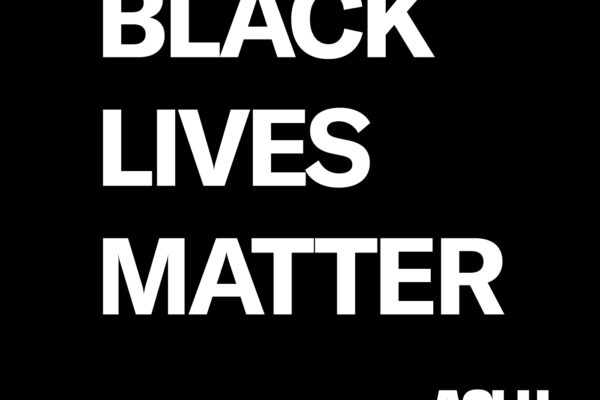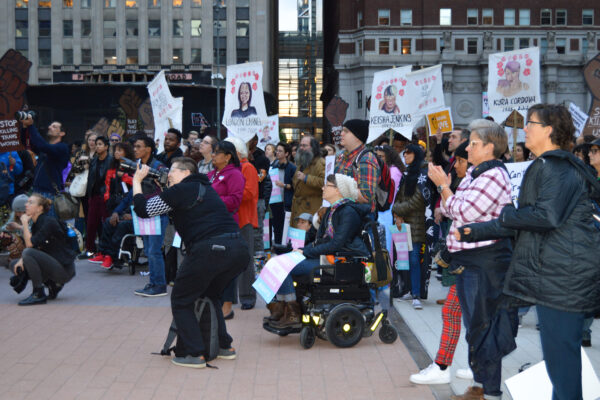- Publications >
- Report
"Both Spectacular and Unremarkable:" A Letter to the United Nations on Police Violence in Philadelphia
Document Date: December 1, 2020
Note: the video here and those linked below contain scenes of violence and/or explicit language.
As protests for Black lives and against police violence began on May 30, 2020 in Philadelphia, the Philadelphia Police Department used overwhelming, racially-targeted, and excessive force to discourage these protesters from exercising their constitutional and human rights. Philadelphia police used force indiscriminately against protesters, legal observers, journalists, medical personnel, bystanders, and even residents in their homes.
At the same time, police empowered white groups, who were often armed with bats, clubs, and even military-style automatic weapons, to take over streets and parks, make threats of violence, and even assault protesters for Black lives. Philadelphia police went so far as to forcibly disperse anti-racism protesters instead of dispersing the white groups that threatened violence against them.
That’s why the ACLU of Pennsylvania teamed up with Drexel University’s Stern Community Lawyering Clinic at the Kline School of Law to send a letter of complaint to the United Nations, detailing the use of violence and excessive force by police against Black Lives Matter protesters in May and June of 2020.
Below is a timeline of the protests and police response from May 30, May 31, and June 1 in Philadelphia.
Jump to:
Read the full letter
Events of May 30, 2020
Events of May 31, 2020
Events of June 1, 2020
Organizations on the ground
May 30, 2020
2:30pm — Center City
Approximately 3,000 peaceful protesters began to march from the Art Museum to City Hall. A few individuals in the crowd spray-painted buildings and damaged police cars along the way. In response, Philadelphia police deployed officers in riot gear, armed with batons and rubber bullets.
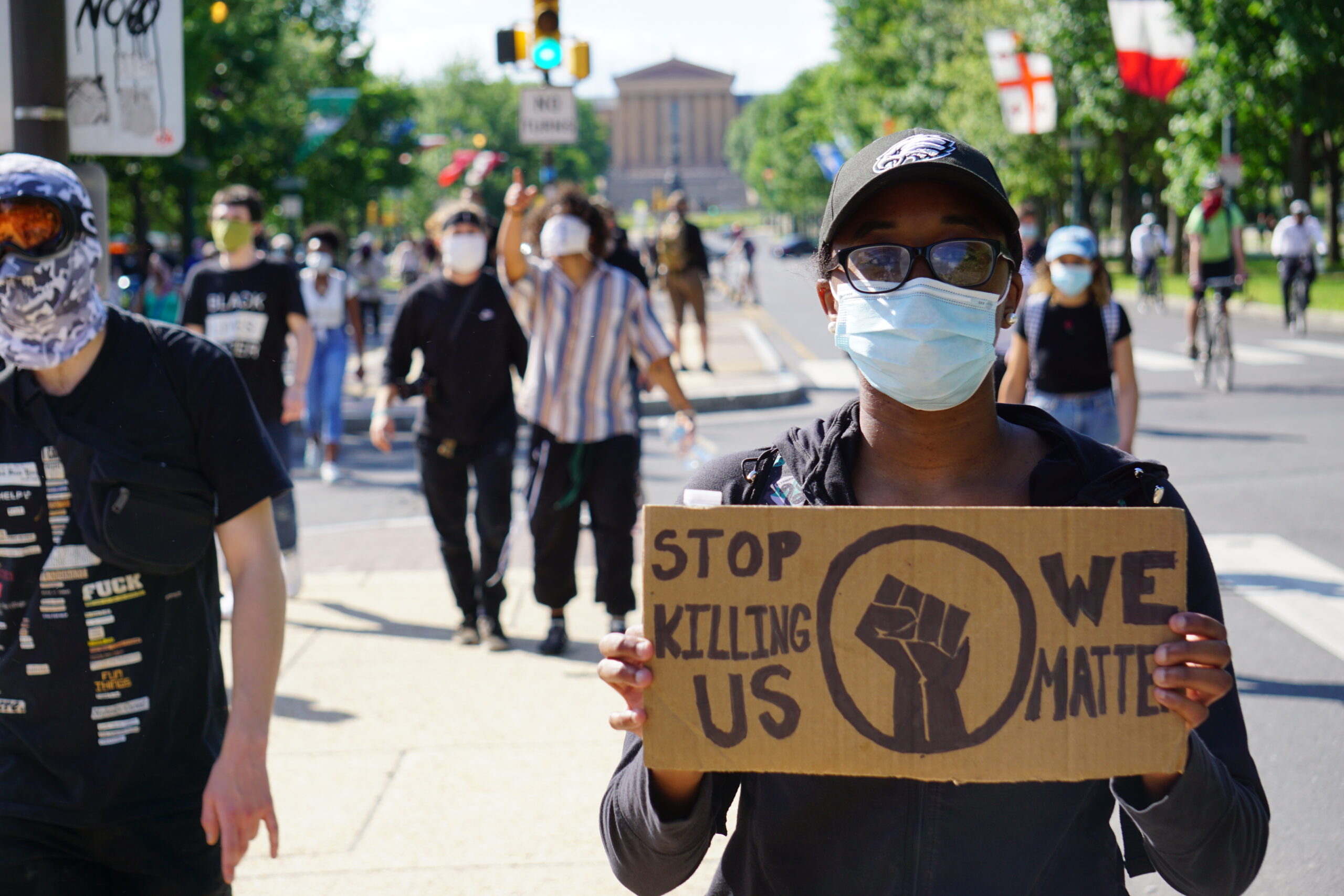
7:05pm — City Hall
Mayor Jim Kenney issued a citywide curfew, effective at 8pm that day, lasting until 6am on May 31. During his announcement, the mayor and other officials acknowledged that the destruction was caused by “outside agitators,” not the non-violent protesters from earlier in the day.
May 31, 2020
The morning of May 31, West Philadelphia was peaceful and unremarkable. After the city-wide curfew was lifted, many neighbors were out enjoying the warm spring morning, congregating in local parks, and going about business as usual.
2:00pm — Intersection of 52nd and Market Streets
Shortly after 2:00pm, the police began to talk about “taking 52nd and Market.” Groups of police began gathering at the 52nd Street commercial corridor as early as 2:15pm. Starting at 2:45pm, the dispatch began calling “all available units” to 52nd and Market. Shortly thereafter, the police descended upon 52nd Street. At the time, it wasn’t clear to witnesses why the police were “assembling an army on empty streets” and a small group of community members gathered, trying to figure out what the police were doing there.
2:45pm — 52nd Street elevated train
As police gathered underneath the train tracks, a group of 30 children and adolescents from the community, around 16-years-old and under, assembled not far from where the police were lined up, curious and angry about the police’s presence. The police were in SWAT gear, including body armor, helmets and shields. The children yelled and occasionally threw half-full water bottles, stones, and pieces of brick at the vehicles and police officers. In response, the police did not tell the children to disperse, or give any direction, but instead threw the water bottles and debris back at them many times. At one point, an officer threw a piece of cement at the children and it struck a nine year old girl. Meanwhile, as the officers targeted the group of children, some people damaged abandoned police vehicles north of the subway line near Arch Street. The police did nothing to stop this and instead chose to continue to antagonize and assault a small group of children under the cover of the subway tracks.
4:03pm — Intersection of 52nd and Market Streets
Suddenly, an explosion occurred. Within 10 minutes, a helicopter appeared, and a crowd gathered to see what was happening. In the crowd of approximately 150 people, most were shoppers or pedestrians who had unexpectedly walked into the situation. A helicopter siren blared, and police began indiscriminately shooting rubber bullets and tear gas into the businesses and into the crowd gathered there too. People ran from the gas, screaming, as a whitish gray fog visibly drifted east.
4:40pm — 52nd Street
Philadelphia police officially given the “green light” to use tear gas and the police on and near 52nd Street began shooting excessive amounts of tear gas and rubber bullets, causing a stampede. Over the course of the next hour, tanks drove up and down 52nd Street multiple times deploying smoke bombs, tear gas, and rubber bullets indiscriminately along the way.
According to those present, police did not issue any warning before indiscriminately deploying tear gas and rubber bullets. They did not provide an explanation. They did not order people to disperse. The police simply attacked. Onlookers report that there was a mix of people there. Some were there to protest; others arrived with supplies prepared to render aid; yet others became victims for simply living in a neighborhood now under siege.
Over the next hour after tear gas was first authorized at 4:40pm, the air became so thick with gas that you could not see through it. As neighbors scrambled into homes trying to escape the fumes, the gas blew through the opened windows meant to keep a house cool on a warm spring day. Many struggled to breathe as the toxic gas seeped into their homes.
5:30pm — 52nd and Chancellor Streets
At some point between 5pm and 6pm, a group of about 30 residents began to “hold the line” at 52nd and Chancellor Streets in an attempt to make sure the police didn’t progress past Locust Street again into the more residential areas, south of the Strip. The police made no attempt to negotiate with the crowd.
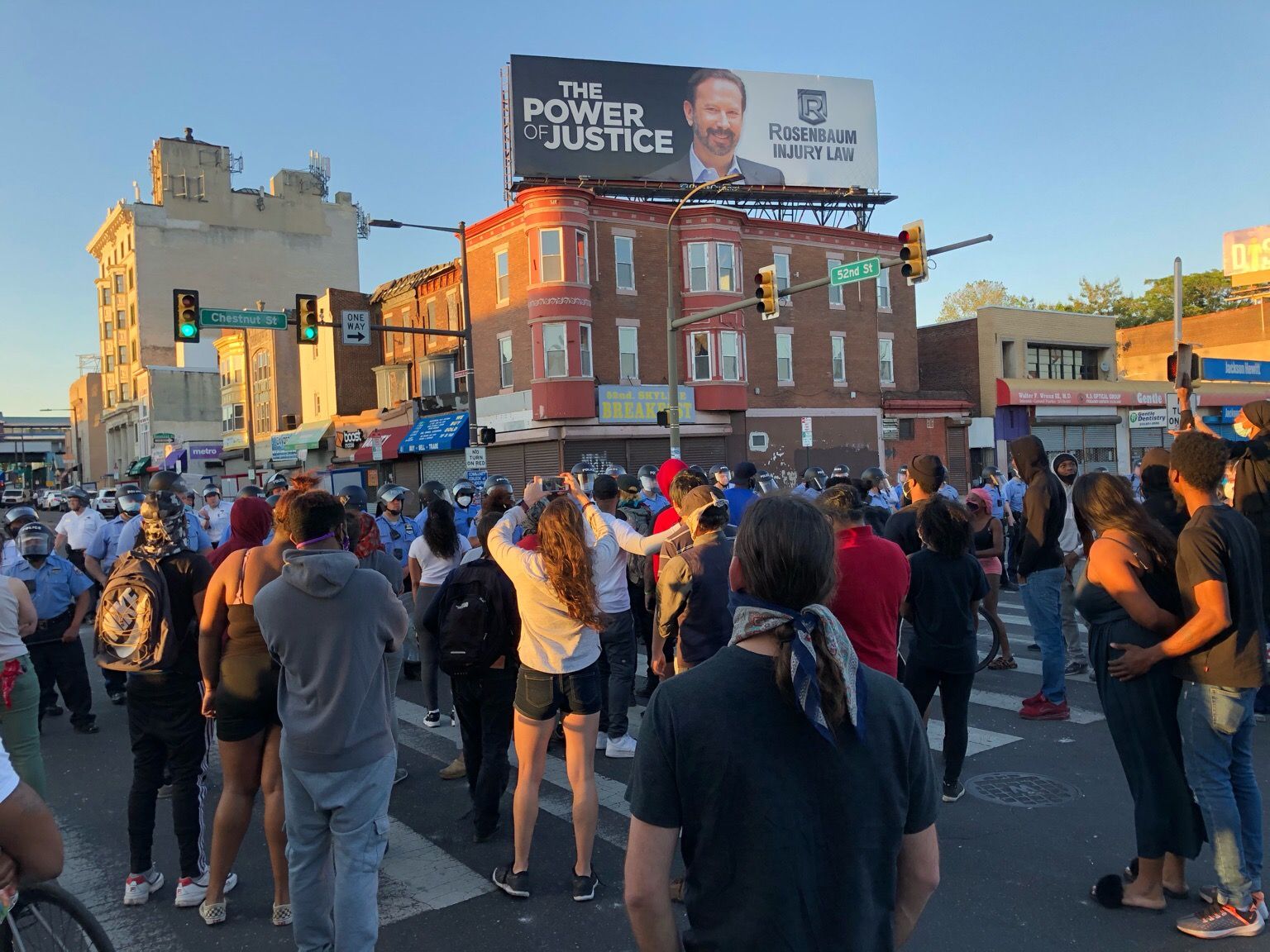
6:30pm — Northern End of The Strip
A large group of police officers dressed in full riot gear formed a line.
Although the City’s curfew started at 6pm that day, a group of approximately 100 people, made up of neighbors and activists, remained on the street “to support the community and to make sure if anything happened, they could share resources.” Many community members questioned why the police were still present, as any property theft and destruction had long subsided. As the crowd began to fade, a smaller group of approximately 25 residents and peaceful activists mostly just “held space” on the corner of 52nd and Arch Streets, playing music and dancing.
9pm — Target store in South Philadelphia
Even as police bore down on residents in West Philadelphia with armored vehicles and weapons, dozens of white self-described “vigilantes” began gathering after curfew at the Target store at 1 Mifflin Street in South Philadelphia with the stated purpose of preventing break-ins like the ones they had seen reported from the previous night in Center City. Despite the curfew, this group remained gathered outside the Target with the sanction of the police, who received a round of cheers from the group when they came to the scene around 9:00pm round 11:00pm, more than five hours after the curfew began, the vigilante group was still guarding the store.
Police officers in white shirts stood close by, circled around a police vehicle, and some spoke with organizers throughout the night. Police made no arrests.
10:30pm — 52nd and Arch Streets
Philadelphia police’s SWAT team and the National Guard showed up and unleashed a new round of violence. SWAT began to fire rubber bullets into the crowd, hitting multiple people at close range. As things began to escalate, some of the protesters ran to a nearby house. Nine or ten SWAT team officers chased them onto the porch of the house. The officers shined lights into the house and ultimately left. However, the victims reported that they “thought that SWAT was going to break the door down.” The occupation of West Philadelphia by police officers continued until 2:00 a.m. Monday morning, June 1, 2020. One victim, who has had many violent experiences with police as a protester, reported that “the level of violence was so much bigger than anything [she] had ever seen before. I have never seen tanks on residential streets like that.
11:15pm — Target store in South Philadelphia
Seeing that the police allowed the vigilante group to stay out past the city’s curfew, a group of Black residents arrived at the Target to ask why. The group of vigilantes began to shout, asking what the Black residents were doing there. Arguments broke out between the two groups, while police stood by and watched. When people were finally asked to disperse, the police allowed a small group of white men to stay at the store in the company of police officers despite sending the Black residents home.
June 1, 2020
3:00pm — Philadelphia Police Headquarters
Several hundred peaceful demonstrators protest outside of the police headquarters before marching toward City Hall, and then down the Benjamin Franklin Parkway. As the crowd marched, it grew in size to what witnesses estimate was some 5,000 people.
4:00pm — Interstate 676
From the Parkway, some of the crowd entered Interstate 676. Several police officers were stationed on the on-ramps as protesters passed, but none of them ordered the protesters to stop. As protesters entered the highway, traffic stopped in both directions. By all accounts, protesters acted peacefully as they marched around the stopped cars; one officer even described the highway protest as “peaceful” over the police radio.
4:15pm — I-676 Tunnel Under 20th Street
Some protesters headed east towards a tunnel where the highway runs under 20th Street. When the protesters entered the tunnel, PPD officers in SWAT uniforms were there to meet them. Without warning, the officers began pepper-spraying the protesters. While some protesters fell to their knees and put their hands up, the officers didn’t let up.
In at least one instance, an officer pulled down a protester’s mask and pepper-sprayed him in his face from inches away. Another protester fell to the ground but when protesters tried to help the injured protester to safety, the officers physically prevented the aid.
5:00pm — West Side of I-676
From the west, SWAT teams also moved in on the protesters, this time with armored vehicles. In response, protesters knelt on the street, many with their hands in the air chanting “Hands up, don’t shoot.” The police responded with tear-gas canisters and pepper spray. As with the SWAT officers emerging from the underpass to the east, in at least one instance, an officer pulled down the mask of a kneeling protester to spray them more aggressively. There is no indication that the police gave a warning to disperse before deploying these tactics.
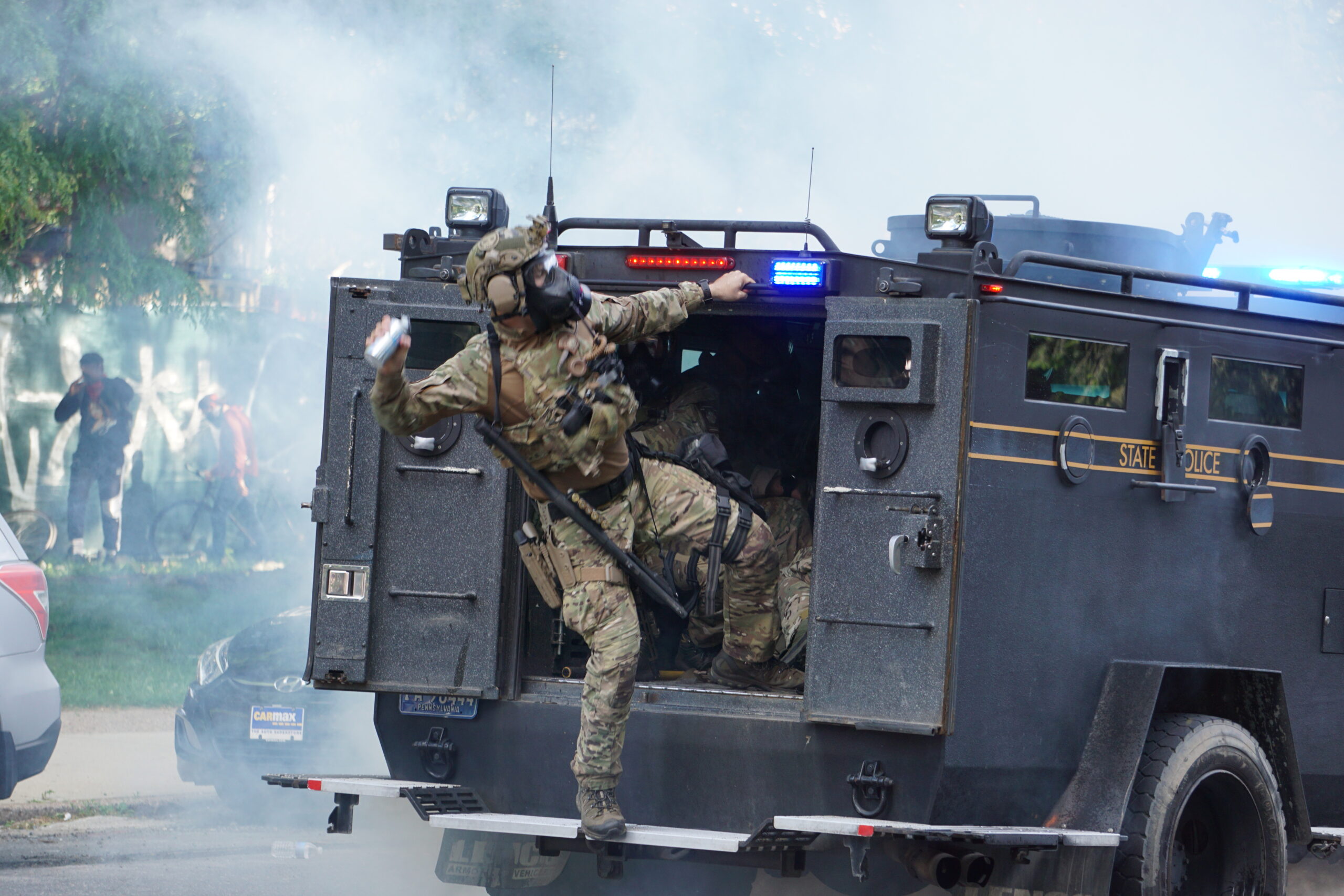
As the teargas began to roll in from the west, protesters gathered on the highway found themselves cornered between the suffocating gas coming towards them and the line of officers with pepper spray to their east. To the south, a high concrete wall separated the highway from the rest of the city. As the officers advanced with teargas, people looked for safety in the only possible direction: to the north. Some protesters escaped the highway through an unfenced embankment, but many others were left with no option but to climb a steep hill and attempt to scale an eight-foot-tall fence. At least one officer encouraged protesters to flee that way.
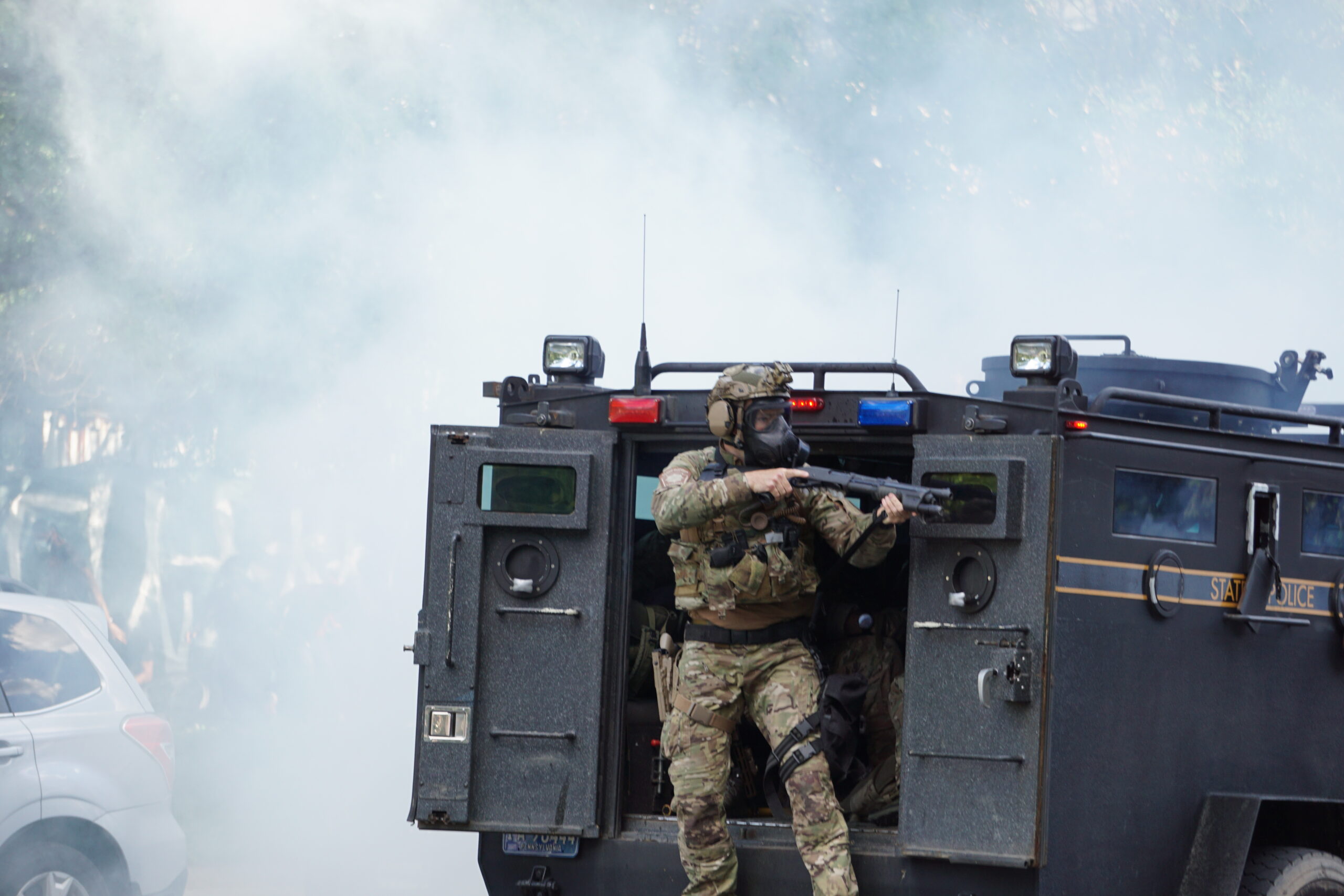
Officers then attacked the fleeing protesters on the hill with even greater force, causing a stampede. While protesters tried to help each other to scale the tall fence at the top of the hill and protect those that fell down in the rush to escape, police officers shot rubber bullets and tear gas canisters in their direction.
Witnesses recalled being “crushed against the wall,” and “packed in like sardines,” as more protesters sought an escape from these weapons. Police arrested dozens of these protesters who they forcibly prevented from escaping the tear gas.
5:15pm — Fishtown
At the same time as police were trapping and tear-gassing unarmed protesters on Interstate 676, a notably different dynamic was developing between police and many armed white civilians in the Fishtown section of Philadelphia, just four miles away. On the afternoon of June 1, 2020, dozens of mostly white men, armed with baseball bats, metal pipes, axes, golf clubs, and firearms, gathered outside the entrance of the 26th Philadelphia Police District headquarters on East Girard Avenue with the stated purpose of “protecting” the neighborhood. As these men gathered with their weapons of choice around the District headquarters, a group of police officers stood on the street outside. The officers chatted with these armed men, and some even shared pizza and sandwiches with them. The group gradually swelled to about a hundred people.
Local and national media outlets covered the Fishtown events extensively. Reports emphasized confusion about why self-described “vigilantes” were permitted to roam past curfew, armed, on the same night that Black Lives Matter activists were arrested for peaceful protests.
The crowd’s presence drew a group of counter-protesters affiliated with the Black Lives Matter movement who gathered to oppose the white group’s threatening presence. around 5:15pm, a “neighborhood defender” crossed Girard Avenue, grabbed a woman’s Black Lives Matter sign, and ripped it up. Witnesses reported several similar efforts to deface signs as well as threats that the “neighborhood defenders” hurled at the Black Lives Matter protesters. Police in Fishtown took no action as these mostly white men continued walking the streets of the neighborhood wielding their weapons, while the same police department was arresting unarmed Black Lives Matter protesters in Center City. When Black Lives Matter protesters requested protection from the armed men in Fishtown, police blamed them for “escalating the situation.
7:00pm — Fishtown
Directly across from the 26th Police District headquarters, a “neighborhood protector” aggressively shoved a male Black Lives Matter protester who was accompanied by a female protester holding a sign that read “I Can’t Breathe” in front of William Fisher, Captain of the 26th Police District. The captain merely shooed away the man who shoved the protester. The agitators also assaulted a WHYY reporter who had been filming them, causing injuries that required hospital treatment.
Police reported making zero arrests on any charge within a half-mile of the 26th District headquarters. Bystanders documented only one instance of police intervention: videos on Twitter show a Black man unaffiliated with the “neighborhood protectors” being taken into police custody for allegedly possessing an ax after a “neighborhood protector” chased him down the street and threw a bat at him.
Conclusion
The violence perpetrated by Philadelphia police in May and June has had lasting impacts on residents, who are living with the effects of physical harm and emotional trauma. The events inverted the role of residents and the police. Philadelphians put themselves in harm’s way to protect neighbors, friends, and complete strangers from violence by police. Despite the danger presented by police presence, many continued to assert their right to assemble and protest. All this, as police protected and praised white vigilantes.
The letter sent to the UN proposes remedies and reparations based upon victims’ vision for what true accountability, justice, and repair should be. We include a proposed set of questions that seek clarity regarding how the City is planning to investigate and address these events.
Here are some local groups working on police reform in Philadelphia:
Andy and Gwen Stern Community Lawyering Clinic
Penn Community for Justice
Abolitionist Law Center
Amistad Law Project
Reclaim Philadelphia
Black Lives Matter Philly
Philly Socialist Alternative
Party for Socialism and Liberation (PSL)
Black Philly Radical Collective
Movement Alliance Project
Philadelphia Community Bail Fund
Black and Brown Workers Cooperative
YEAH Philly
Philadelphia Student Union
Philly for REAL Justice
Juntos
Decarcerate PA
215 People's Alliance
Philly We Rise
Vietlead
Coalition to Abolish Death by Incarceration
Photo Credits: Benjamin Peifer
Related Content
Stay Informed
Sign up to be the first to hear about how to take action.
By completing this form, I agree to receive occasional emails per the terms of the ACLU’s privacy statement.
By completing this form, I agree to receive occasional emails per the terms of the ACLU’s privacy statement.

